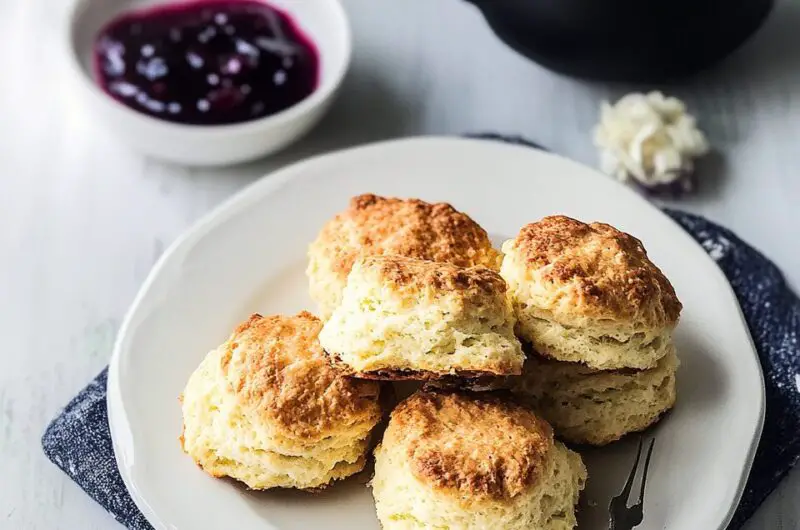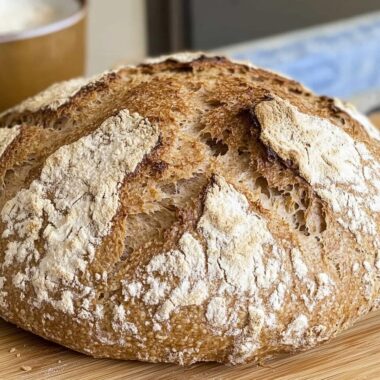These Irish Scones are a classic, buttery delight, perfect for pairing with your favorite tea. The golden-brown exterior gives way to a soft, flaky inside that melts in your mouth. Whether enjoyed fresh out of the oven with butter or complemented by jam and whipped cream, these scones make every tea time feel special. What makes these scones truly exceptional is their simplicity. Made with just a handful of ingredients, they rise tall and bake beautifully every time. Whether you’re celebrating St. Patrick’s Day or simply craving a cozy homemade treat, these Irish Scones will transport you straight to the heart of Ireland with every bite.
Full recipe:
Ingredients:
- 3 ½ cups all-purpose flour
- ¼ cup sugar
- 5 teaspoons baking powder
- ⅛ teaspoon salt
- ½ cup salted butter, cold and cubed
- ⅔ cup milk (2%)
- ⅓ cup heavy cream
- 1 large egg
- 2 tablespoons milk or cream (for brushing tops)
Directions:
- Preheat your oven to 375°F (190°C). Line a baking sheet with parchment paper.
- In a medium bowl, whisk together flour, sugar, baking powder, and salt.
- Add cold cubed butter to the dry ingredients and use your fingers to work it in until the mixture resembles coarse meal.
- In a small bowl, combine the milk, cream, and egg, whisking well.
- Pour the wet ingredients into the flour mixture and mix lightly until a dough forms.
- Turn the dough onto a lightly floured surface and knead gently to form a smooth ball. Pat the dough to about 1 inch in height.
- Use a round cutter to cut out scones, re-rolling scraps as needed.
- Place scones on the lined baking sheet and brush the tops with milk or cream.
- Bake for 25 minutes or until puffed and golden brown.
- Remove from oven and let cool slightly on a wire rack. Serve warm with butter, jam, or whipped cream.
Prep Time: 10 minutes | Cooking Time: 25 minutes | Total Time: 35 minutes
Kcal: 254 kcal | Servings: 12
Introduction
Irish Scones are a beloved staple in traditional Irish baking, known for their buttery, flaky texture and simple yet satisfying flavor. Unlike their sweeter counterparts in America, Irish scones are less sugary, allowing the quality of the butter and cream to shine through. They are often enjoyed warm with a pat of butter, a dollop of jam, or even clotted cream, making them a perfect addition to any breakfast, brunch, or afternoon tea. In this article, we’ll dive deep into the history of Irish scones, why they’re so popular, the benefits of making them at home, and tips to ensure they come out perfect every time. Whether you’re celebrating St. Patrick’s Day or just want to experience a taste of Ireland, this guide will help you master the art of making authentic Irish scones.
A Brief History of Irish Scones
Scones have been a part of Irish cuisine for centuries, dating back to the early days of Ireland’s agricultural society. The name “scone” is believed to originate from the Dutch word schoonbrot, meaning “beautiful bread,” or the Gaelic word sgonn, meaning a “large mouthful or lump of bread.” Historically, scones were made using simple ingredients that were readily available on Irish farms, such as flour, butter, milk, and eggs. Unlike yeast-based breads, scones rely on baking powder as a leavening agent, which was a relatively new addition to baking in the 19th century. This made scones easy and quick to prepare, leading to their widespread popularity. One of the most famous traditions involving scones is the Irish afternoon tea, which became a social custom in the 1800s. Along with a pot of hot tea, freshly baked scones were served with clotted cream and jam, making for a comforting and satisfying treat.
Why Irish Scones Are the Best
- One of the best things about Irish scones is that they are made from basic pantry staples, yet they produce an irresistibly rich and tender pastry. The combination of cold butter, heavy cream, and a touch of sugar creates a perfectly balanced texture—flaky on the outside and soft inside.
Quick and Easy to Make
Unlike yeast-based bread or pastries that require proofing, Irish scones come together in under an hour. You don’t need any special equipment—just a mixing bowl, a pastry cutter (or your hands), and a baking sheet.
Versatile and Customizable
- Though traditional Irish scones are plain, they can be easily customized to suit different tastes. Popular variations include adding dried fruit (raisins, currants, cranberries), citrus zest, or even savory additions like cheese and herbs.
Perfect for Any Occasion
- Irish scones are a delightful treat for breakfast, brunch, tea time, or even as a light dessert. They are commonly enjoyed during celebrations like St. Patrick’s Day but are just as wonderful for a cozy weekend morning.
Healthier Than Store-Bought Pastries
- By making scones at home, you can control the quality of ingredients, avoiding artificial preservatives and excess sugar. Using high-quality Irish butter and organic dairy can enhance both the flavor and nutritional value.
The Secret to Perfect Irish Scones
Achieving the perfect scone comes down to a few key techniques:
Use Cold Butter
- Cold butter is essential for flaky scones. When the butter melts during baking, it creates steam pockets that help the scones rise and develop their tender texture. To ensure your butter stays cold, cube it ahead of time and store it in the refrigerator until ready to use.
Don’t Overwork the Dough
- Kneading the dough too much will activate the gluten in the flour, leading to dense and tough scones. Mix the ingredients gently and stop as soon as the dough comes together.
Use High-Quality Ingredients
- For the best flavor, use real Irish butter and fresh dairy products. These ingredients make a noticeable difference in the richness and texture of the scones.
Avoid Twisting the Cutter
- When cutting out scones, press the cutter straight down and lift it up without twisting. Twisting the cutter seals the edges, preventing the scones from rising evenly.
Brush with Milk or Cream Before Baking
- Brushing the tops of the scones with milk or cream gives them a beautiful golden color and slightly crisp texture. For extra sweetness, you can sprinkle a little sugar on top before baking.
Variations of Irish Scones
While traditional plain Irish scones are delightful on their own, there are many creative ways to enhance the recipe:
Fruit Scones
- Add ½ cup of raisins, currants, or dried cranberries to the dough for a slightly sweet variation.
- Fresh berries like blueberries or raspberries can also be folded into the dough for a juicy burst of flavor.
Savory Scones
- Reduce the sugar and add grated cheddar cheese and chopped chives for a delicious savory option.
- Bacon and herb scones are another popular twist, perfect for serving alongside soups or stews.
Lemon or Orange Zest Scones
- Add 1 tablespoon of lemon or orange zest to the dough for a citrusy aroma.
- Serve with lemon curd or marmalade for an extra layer of flavor.
Whole Wheat Scones
- Replace half of the all-purpose flour with whole wheat flour for a nuttier taste and added fiber.
Serving Suggestions
The beauty of Irish scones lies in their versatility. Here are some ways to serve them:
Classic Butter and Jam
- Enjoy scones warm with a pat of butter and a spoonful of homemade berry jam. This classic combination allows the flavors of the scones to shine.
Clotted Cream and Preserves
- For an authentic Irish or British afternoon tea experience, serve scones with clotted cream and strawberry preserves. The rich, creamy texture pairs beautifully with the slightly sweet jam.
Honey and Whipped Cream
- For a simple yet indulgent twist, drizzle scones with honey and add a dollop of freshly whipped cream.
With a Cup of Tea or Coffee
- Irish scones are the perfect companion to a hot cup of tea (Earl Grey, Irish Breakfast, or Chamomile) or freshly brewed coffee.
How to Store and Reheat Irish Scones
If you have leftovers, follow these storage tips to keep your scones fresh:
Room Temperature:
- Store scones in an airtight container for up to 2 days.
Refrigeration:
- For longer storage, keep them in the refrigerator for up to 5 days.
Freezing:
- Place scones in a zip-top freezer bag and freeze for up to 3 months.
- To reheat, place frozen scones in a 300°F oven for 10 minutes or until warmed through.
Conclusion
Irish scones are more than just a simple baked good—they are a beloved tradition that brings comfort and warmth to any table. Their versatility, ease of preparation, and deliciously buttery texture make them a must-try recipe for anyone who loves baking. Whether you enjoy them plain, with jam, or with a touch of clotted cream, Irish scones are sure to become a favorite in your home. So, gather your ingredients, preheat your oven, and experience the joy of baking these timeless treats!








